Updated August 5, 2023
Restrictions on liquids, aerosols, gels, creams, and pastes are an ally of the packing light traveller. Toiletries can be space and weight guzzlers, so it could be helpful to look upon the restrictions as additional motivation to pack light. Hopefully this list of 18 tips on organizing a 3-1-1 bag for toiletries and cosmetics is a helpful starting point.
Table of Contents
- Why the restrictions?
- What is the 3-1-1 rule?
- 3-1-1 rules vary
- Exemptions to the 3-1-1 rule
- Tips on organizing a 3-1-1 bag for toiletries and cosmetics
- 1. Use a working list
- 2. Evaluate each item
- 3. Look for solid substitutes
- 4. What can perform double duty?
- 5. Figure out how much you’ll need
- 6. Set aside samples
- 7. Cruise dollar-store aisles for travel-sized containers
- 8. Collect containers
- 9. Need more than 100 ml / 100 g?
- 10. What’s available at your destination?
- 11. Decant
- 12. Avoid leakages
- 13. Label containers
- 14. Share the load
- !5. Use a packing list
- 16. Make your 3-1-1 bag do double duty
- 17. Choose an ultralight hanging toiletries bag
- 18. Leave your 3-1-1 bag packed
Why the restrictions?
Restrictions were introduced in 2006 on the heels of a foiled terrorist plot to bomb planes using liquids as explosives. Limiting the number of containers that can fit inside a small bag prevents what’s been described as a ‘critical diameter’ to blow anything up.
The restrictions were meant to be temporary. They may be lifted in the not-too-distant future thanks to technology being tested at some airports. In the meantime, we’re stuck with conforming to the ‘3-1-1 rule’ as it has come to be known in some countries.
What is the 3-1-1 rule?
Restrictions vary from country to country but generally, the rule limits the quantities of liquids, aerosols, gels, creams, and pastes in carry-on luggage. It doesn’t apply to the contents of checked baggage. Passengers must use containers no larger than 3.4 ounces (100 ml). All containers must be placed in a one-quart/one-litre transparent, sealable bag. Each passenger must have just one bag. Hence, 3-1-1.
Note that ‘3’ refers to containers, and not contents. I’ve observed screening agents confiscate larger containers from passengers. Judging from the conversations, some of these travellers mistakenly believed that because the small amount in the container was less than 3.4 oz / 100 ml / 100 g, it was allowable.
The Transportation Security Administration (TSA) of the United States has a short video on the rule. TSA has a My TSA app with loads of helpful information on a variety of related topics. Travellers can use the “Can I Bring My…” feature to determine if items are prohibited or not, and which ones are subject to the 3-1-1 rule. There’s also a web-based version of the “Can I Bring My…” tool.
Other countries have similar regulatory authorities and helpful information on dedicated websites.
Keep in mind that items such as jams, syrup, and drinks also fall under the restrictions. If you expect to have quantities that exceed the restrictions, plan to check a bag or alternatively, make a purchase after clearing security screening.
3-1-1 rules vary
Rules vary from country to country
From time to time, review the guidelines of the Canadian Air Transport Security Authority (CATSA), Transportation Security Administration (TSA) in the US, or those of a similar agency operating in the countries you’ll be visiting.
Take Australia as an example. According to TravelSECURE, Australia’s regulatory authority:
- “Flights within Australia are not subject to restrictions on how much powder, liquid, aerosols and gels you can carry onboard.
- However, if you are travelling domestically, but departing from an international terminal (for example, Terminal 1 in Sydney or Terminal 2 in Melbourne—your boarding ticket will confirm if you are departing from an international terminal), you are subject to powder, liquid, aerosol and gel restrictions.
- In particular, all aerosol containers must have a fitted cap, or locking device.”
Rules vary for other reasons
In March 2020, in response to the coronavirus, TSA announced a temporary increase in the amount of hand sanitizer a passenger could bring into the cabin in carry-on luggage. One bottle of hand sanitizer up to 355 ml doesn’t need to be packed in the one-litre resealable bag with other liquids, aerosols, gels, creams, pastes, and powders.
Exemptions to the 3-1-1 rule
There are exceptions. Reasonable quantities of liquids to be used during the trip for medical purposes or special dietary requirements aren’t subject to the restrictions. Saline solution, doctor-prescribed medication, and breast milk are examples. However, these need to be declared to a screening agent as soon as you arrive at the security checkpoint. Carry evidence such as a doctor’s letter explaining why the medication is necessary.
Cremated human remains are also exempt, as well as organic powders such as powdered foods, coffee, protein powder, and baby formula.
Tips on organizing a 3-1-1 bag for toiletries and cosmetics
1. Use a working list
Begin by listing all toiletries, cosmetics, and any other liquids, aerosols, gels, pastes, and powders you’d like to pack.
If it helps, physically line up the full-sized versions of the products you’d like to take.
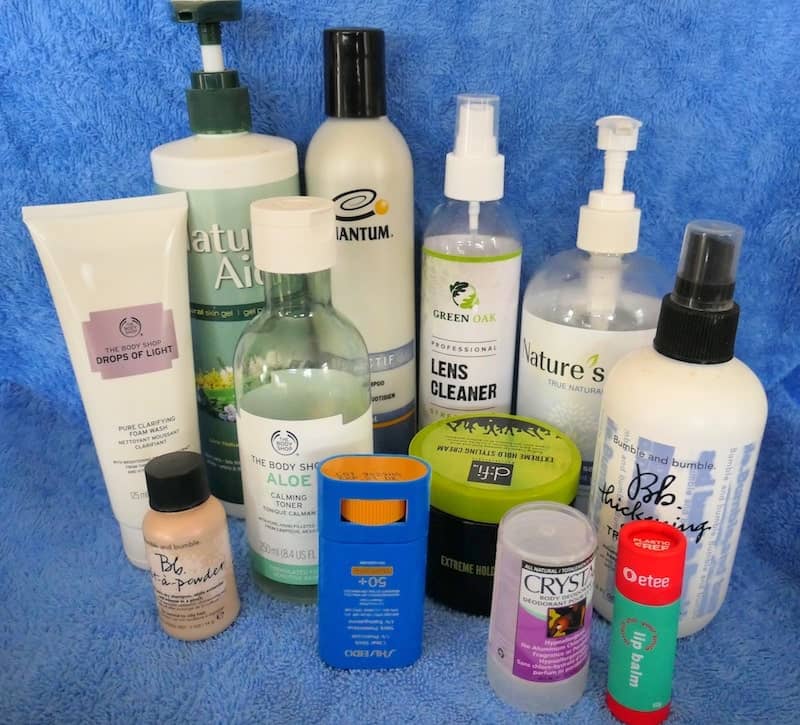
2. Evaluate each item
When it comes to cosmetics and toiletries, do you need to take the full range of products you use at home? What can you do without? Are you willing to try an alternative product that takes up less space?
- Do you need hair conditioner? Could a shampoo with a moisturizing component satisfy your needs for the time you’ll be away?
- Is a daily mouthwash necessary? Might a small pack of Listerine Breath Strips do in a pinch?
- Do you regularly use perfume? Consider a scent-free journey. Nearby passengers, especially those with multiple chemical/fragrance sensitivities will have a healthier trip as a result.
- Do you need shower gel, shampoo, and facial cleanser? Would you consider a product performing all three functions?
- Might a small pack of soap leaves work for toilet facilities without soap?
For more information on this handy travel product, see No soap? No problem travelling with soap leaves
3. Look for solid substitutes
Non-liquid alternatives relieve some of the pressure of fitting everything in a one-litre/one-quart bag.
Deodorant, facial cleanser, shampoo, toothpaste, moisturizer, and sunblock are available in solid form. There are non-liquid products available as body wash or breath freshener, or for sanitizing hands, washing clothes, or removing makeup.
An added advantage is that they don’t leak. Another is that they usually present opportunities to reduce the amount of plastic that travellers are carrying and discarding.
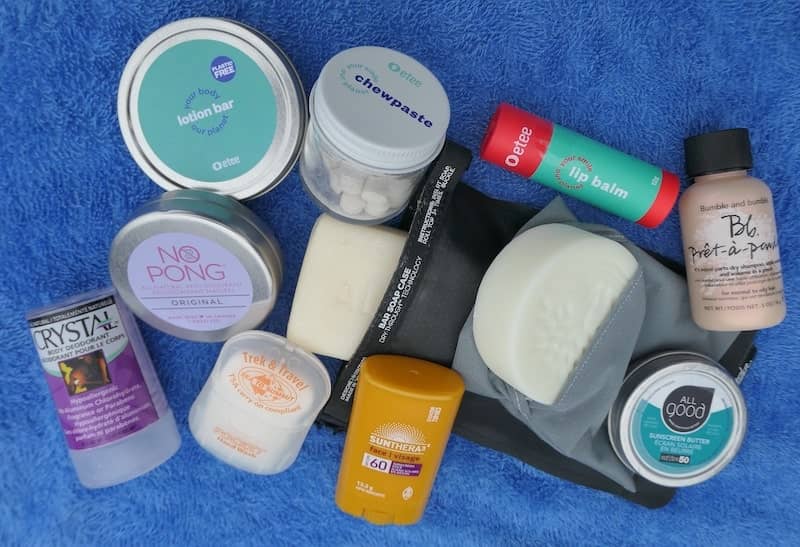
4. What can perform double duty?
Test products capable of performing double or triple duty. For example:
- Tinted lip balms could perform double duty as lipstick and moisturizer, and those with an SPF (sunscreen protection factor) provide protection from the sun.
- A popular choice is Dr Bronner’s 18-in-one Hemp Pure Castille soap. It’s environmentally friendly, lathers beautifully, and has no synthetic preservatives, fragrances, thickeners, or foaming agents. It can be used as body wash, facial cleanser, shampoo, laundry soap, dish soap, or shaving cream. My favourite is lavender. It’s available in liquid or solid form.
5. Figure out how much you’ll need
It’s not efficient to carry around quantities that aren’t needed. Use the smallest possible bottle, jar, or tube for each product. It doesn’t make sense to put 30 ml of product in a 100-ml bottle and have valuable space in a 3-1-1 bag taken up with air.
Pack just enough. To determine what ‘just enough’ looks like, place estimated amounts in travel-sized toiletry containers and take them for a test run at home. For small amounts, use the smallest possible container to help free up space in your 3-1-1 bag.
6. Set aside samples
Save samples. Sephora, Kiehl’s, Clinique, The Body Shop, and a host of other companies provide free or bonus samples in travel-sized containers. Save the containers for decanting from larger quantities.
7. Cruise dollar-store aisles for travel-sized containers
Purchase travel-sized containers of products such as mouthwash, lotion, or hand sanitizer with the plan to refill them with similar products. I find these containers are usually more robust and functional than the empty ones in kits.
The article, Save money for where it counts: cruise dollar store aisles for travel products identifies other gems that could find their way into a travel bag.
8. Collect containers
It’s surprising how much space and weight an off-the-shelf product takes up in packaging and empty space. Collect your own leakproof refillable containers and use them to carry favourite products in the desired quantities. Check out dollar stores, drug stores, travel/outdoor stores, and The Container Store. Or, have a look at the wide selection at the eBay seller Bluebonnet Beauty Supplies.
Avoid kits unless they contain a variety of containers of different sizes and functions. Those with three or four 100-ml containers in a plastic case don’t necessarily permit the best use of space. Figure out what types of containers you’ll need (e.g., spray, flip top, jar, tube, pouch) and approximate sizes, and build your own kit. Some containers work better than others so it might be useful to take them for a test run at home. For example, I discovered that a container with a flip-top lid worked much better than a plastic jar for moisturizer. The lid on the jar would stick, become difficult to open, and the contents degraded faster than product in a container that wasn’t exposed to air and the constant dipping of my fingers in the moisturizer.
For short trips or products where a little goes a long way, check out contact lens cases. They come in a set of two, and are reasonably priced at a dollar store. When cut into two separate containers, each one takes up very little space in a 3-1-1 bag.
If you’re likely to attach containers of products such as sunscreen, hand sanitizer, or insect repellent to the outside of a bag, save those sold with carabiner clips. Or check out human gear GoToob leakproof silicone travel containers with locking lids.
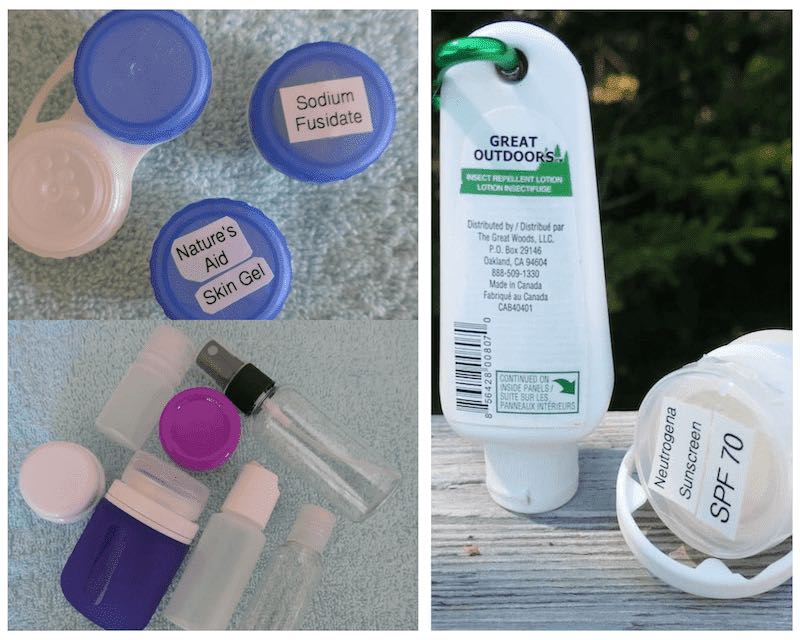
9. Need more than 100 ml / 100 g?
One of my travel companions washes her long hair every day and needs more than 100 ml of shampoo for a trip of any length. As a committed carry-on traveller, she solves the problem by packing more than one container of shampoo. For this purpose, she likes soft-sided squeeze pouches for liquids. When empty, the containers roll up and demand very little space.
10. What’s available at your destination?
One option is to pack less and buy what you need when you get there. But, there’s something to be said about being equipped and ready to go on arrival. Who wants to spend time wading through labels in another language, ending up with a product that isn’t a good match for your hair or skin, paying a higher price, or searching for sizes that don’t add weight and claim more space than they deserve?
Discarding a half bottle of shampoo or moisturizer creates a large environmental footprint. Asking another person if s/he can make use of it isn’t always practical as sharing toiletries isn’t always a healthy option.
For more information, check out Six disadvantages of the ‘buy-it-there’ approach to packing light
Find out if any toiletries are available on a complimentary basis where you’re staying and possibly factor this into your planning. I’ve stayed in hostels with soap and shampoo dispensers, and hotels and apartments where toiletries were supplied.
Have you found a coveted award flight in business or first class on points? Google “what’s in business class amenity kit __ airlines.” Amenity kits typically include body lotion, face cream, lip balm, and facial mist. Depending on your destination and number of segments, you may have access to two or more amenity kits with enough supplies to cover the length of your stay. This scenario presents an option to pack one or two empty containers to fill with products from amenity kits.
11. Decant
Products in travel-sized containers cost more. Those not saved for refilling can be hard on the environment. Decanting gives you greater control over containers and their contents.

Sometimes, decanting is much harder than it needs to be. Luckily, there are several tools that can help get each product into its new container. A beauty spatula can help pull product out of an ’empty’ bottle, and a mini funnel can come in handy. Or, it can be lucrative cutting up an almost empty tube of moisturizer to retrieve the sizeable quantity that would otherwise go to waste. Lotion Saver Bottle Couplers come in three sizes. It’s a simple task to transfer the contents of one bottle into a new one.
12. Avoid leakages
If travelling by plane, leave a little space for the contents to expand with the changes in air pressure during the flight. Some people suggest placing a piece of cling wrap over the container’s opening before screwing on the cap.
A dry sack is a useful packing organizer. It can protect items packed inside (e.g., a phone) by keeping moisture out. It can also protect surrounding items by keeping moisture in. This is handy when packing a wet swimsuit, damp shoes, or liquids in danger of leaking.
My small dry sac is the perfect size to accommodate my Tom Bihn 3-1-1 bag. It’s an extra security against leakages on flights.
The post, 10 Reasons to travel with dry bags provides more information on this handy travel aid.

13. Label containers
Without labels, there’s a risk of reaching for body lotion instead of shampoo. Been there, done that. Having a selection of containers in different sizes, shapes, and colours can help.
If you don’t have a label maker to create durable waterproof labels, look for an affordable kit that comes with them. Many years ago, I bought a Brother PT1650 label maker for gardening, household, and travel-related tasks. It works beautifully for labelling toiletries, chargers, and miscellaneous items..
Or look for containers that are already labelled. Gravel has a two-pack of interlocking bottles with five different labels built into the lid.
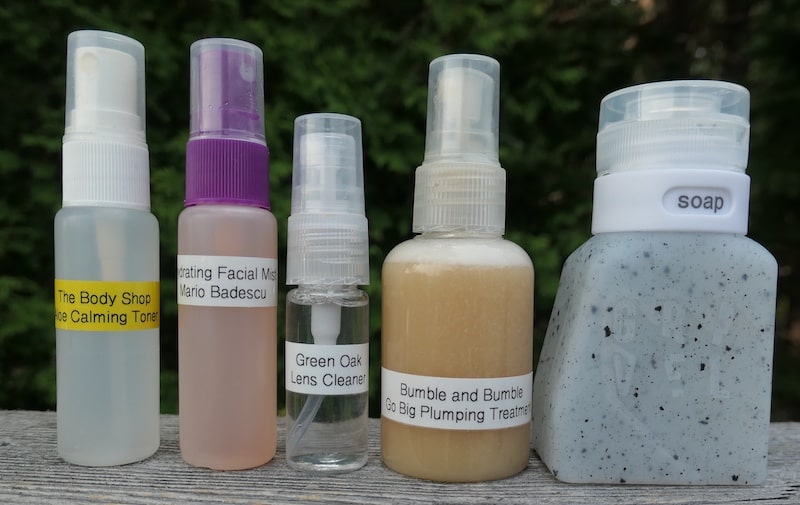
If travelling with another person, it might make sense to share the combined space and weight of two 3-1-1 bags. Also, with health risks taken into consideration, identify what products can be shared so that only one container of a particular product needs to be packed.
!5. Use a packing list
Rules change, and determining what’s classified as a liquid, gel, cream, paste, or powder isn’t always as simple as it sounds. Is dry shampoo a powder and subject to 3-1-1 restrictions? Is lip balm a gel?
In some cases, ‘Can I bring…’ tools haven’t kept pace with the development of products in solid form and travellers are left to guess if sunscreen sticks, lotion bars, and toothpaste tablets fall under the 3-1-1 rule. If unsure, keep these products under 3.4 oz / 100 ml / 100 g when packing in carry-on bags.
As a reminder, it might it help if liquids, aerosols, gels, powders, creams, and pastes on a packing list are identified using a differently coloured font.

16. Make your 3-1-1 bag do double duty
Many screening authorities stipulate that the bag must be plastic, transparent, and sealable. Some jurisdictions specify the type of sealing mechanism as the type found in freezer or sandwich bags. Many airports have these types of bags available for passengers. However, in my experience, zippered bags have always passed muster. Some time ago, my 3-1-1 bag was a repurposed zippered pillowcase packet. It has since been replaced with a Tom Bihn 3D Clear Organizer Cube. With the built-in hook, the Tom Bihn bag converts to a hanging kit. Just in case a screening agent takes issue with the zippered cube, I always carry an empty reusable one-litre freezer bag in my personal carry on.
Consider making your zippered 3-1-1 bag perform double duty as your toiletry and cosmetics kit. It can be a game changer. It has been for me, providing extra incentive to reduce the space and weight demands of my toiletries and cosmetics. After unsuccessful efforts to find a second zippered bag with a built-in hook, I purchased another Tom Bihn 3D Clear Organizer Cube for my solid products. I like the convenience of a hanging kit and when staying in hostels with limited personal space, both are always within easy reach.
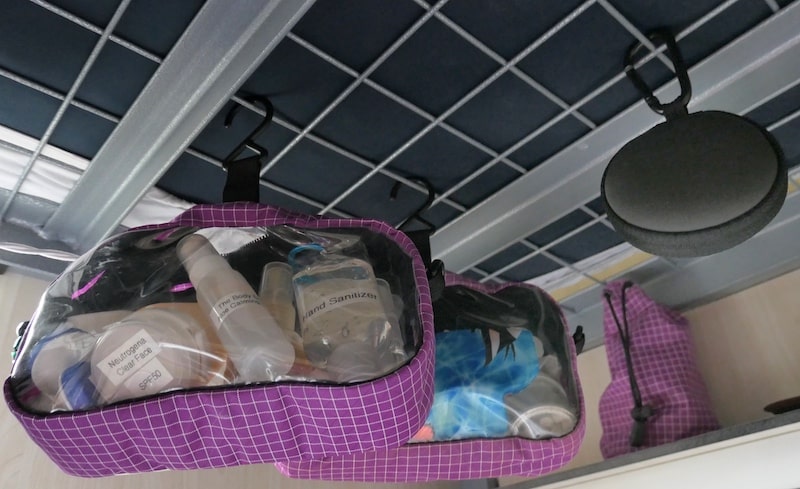
Place your 3-1-1 bag in an accessible outer pocket so it can be quickly retrieved, and then returned to your bag after sceening. Of course for trusted travellers such as NEXUS or Global Entry members travelling through the USA, 3-1-1 bags don’t need to be removed from carry-on luggage. To take advantage of this benefit, ensure your boarding pass contains the TSA Pre✓ ® designation. Although, on my recent trip through multiple airports in September 2023, I wasn’t asked to remove my 3-1-1- bag at screening checkpoints. These included Halifax, Toronto, JFK, Warsaw, Istanbul, Johannesburg, Cape Town, Mauritius, and Paris.
17. Choose an ultralight hanging toiletries bag
If your travel style and packing needs are such that confining your toiletries and cosmetics to a one-quart/one-litre bag is impractical, choose the smallest and lightest hanging toiletries bag possible. Sea to Summit makes a Travelling Light Hanging Toiletry Bag in two sizes. The small weighs just 2.8 oz / 80 g and the large weighs 4 oz / 113 g. The fabric is water resistant, and each bag includes a shatter-proof mirror.
18. Leave your 3-1-1 bag packed
It may seem wasteful to have a set of toiletries specifically for travel, but I find it contributes to a much more efficient packing experience. Back home, evaluate what was used and replenish it, as required, for the next trip. A ready-to-go 3-1-1 bag means one less thing to organize. If no travel is planned, wait until something is in the works. It doesn’t make sense to carry full containers for a weekend getaway. Factor the expiry and Product After Opening dates into this strategy.
The post, Are you travelling with expired toiletries? Avoid doing so with these 14 tips might be helpful in this regard.
Related posts:
- Are you travelling with expired toiletries? Avoid doing so with these 14 tips.
- Pack light with bar shampoo
- Go natural. But does crystal deodorant work?
- Create a travel comfort pack for easy access to self-care essentials
- 10 Reasons to travel with dry bags
- No soap. No problem travelling with soap leaves
If you found this post helpful, please share it by selecting one or more social media buttons. What other tips and strategies can you suggest for organizing a 3-1-1 bag for toiletries and cosmetics? What double-duty or solid products have you found useful? Please add your thoughts in the comments. Thank you.
Care to pin it for later?
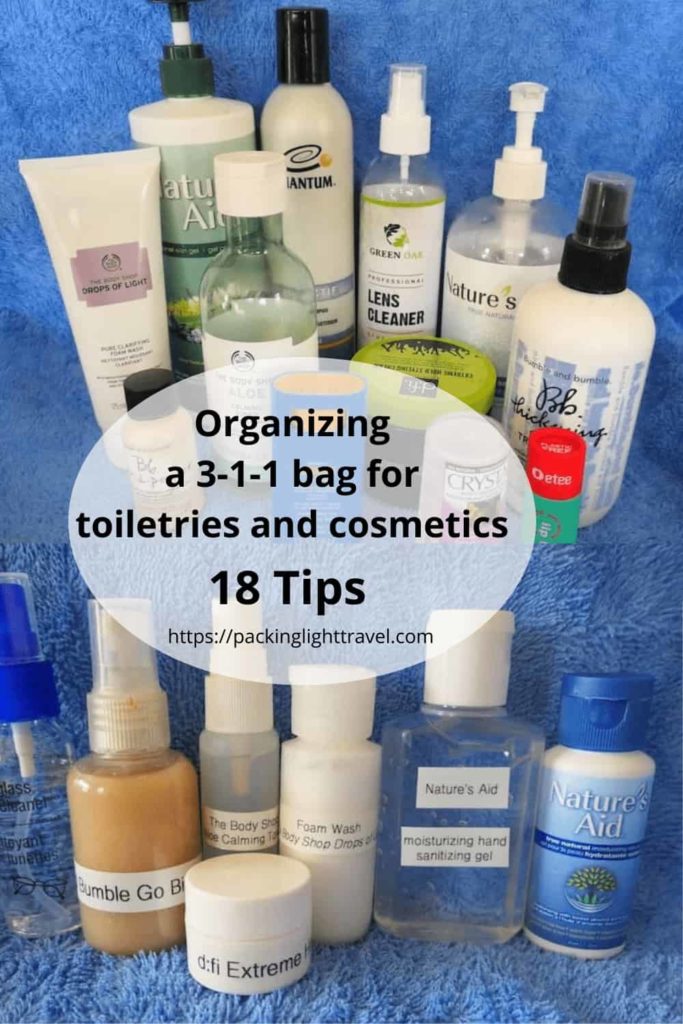
Some of the links on this page are affiliate links. If you click on one and buy something, you don’t pay more, but Packing Light Travel earns a small commission that helps with the costs of maintaining the site. Thank you for your support.

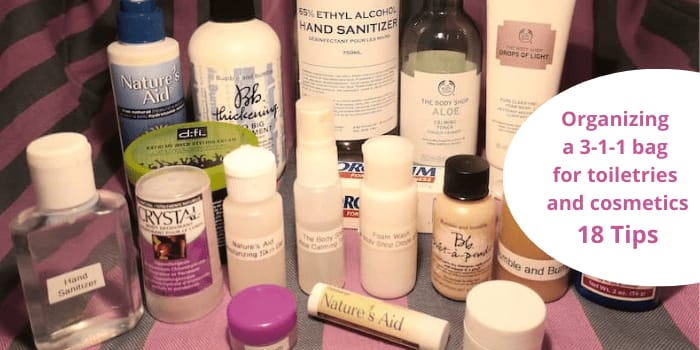
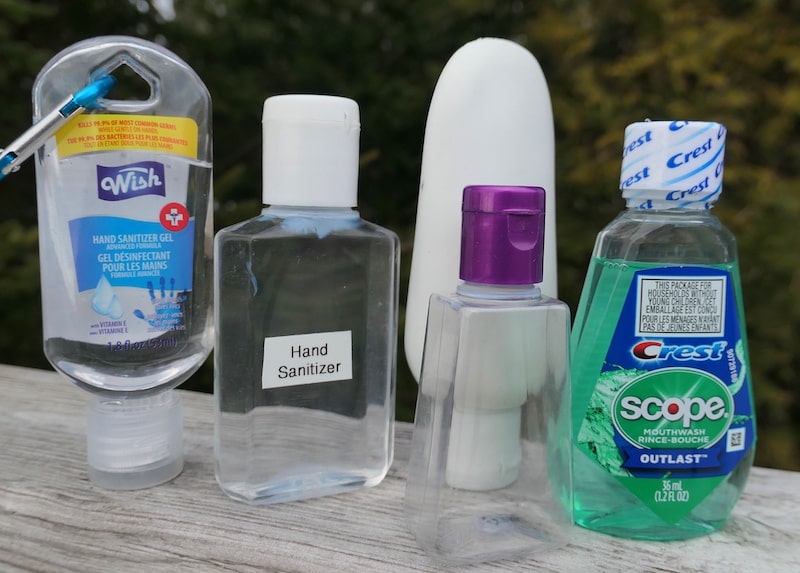




Great information and very useful, if a little U.S. biased.
I always use a key ring fob shaped like a padlock (actually a souvenir from Hong Kong) to clamp the zips together-looks like a padlock, no need for keys, and would take ages to work out how to open it!
Finally, as an essential part of a 3-1-1 bag I always include a re-used airline spirit bottle-50ml.- full of gin. Amazing antiseptic and cheaper than buying one on the aircraft!!
I love packsimply.com – they will pack your selected travel toiletries in a clear bag. Makes it easy to breeze through TSA security check points. Takes out any guesswork!
I would like to know if you do have Toiletries for sale, If YES kindly let me know the major credit cards you accept as form of Payment. I will await your immediate response.
Best Regards
The site shares information. It’s not a marketplace. This, and related posts, offer suggestions on products. All the best in finding products that meet your needs.
Powdered toothpaste can be great for traveling. Doesn’t have to go into the bag, and one small bottle lasts a VERY long time! It is surprisingly good at foaming up and cleaning your teeth.
Hey Anne,
These are some clever tips and tricks that I am sure will help everyone.
We need these products with us when we travel, but we also do not want to carry around all that extra weight. so, packing in small containers is a good idea.
Thanks
Agree! Powdered toothpaste is a game-changer for travel. Compact lasts forever, and is surprisingly effective. 👍